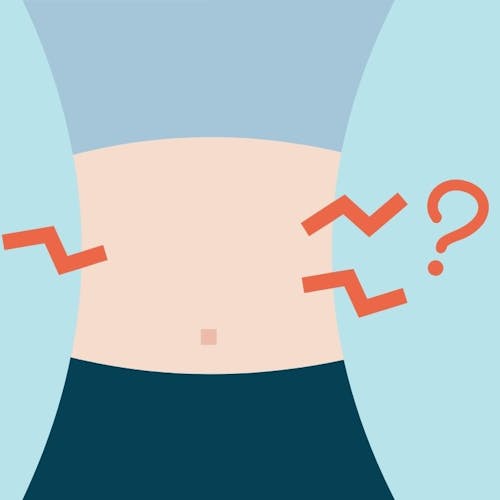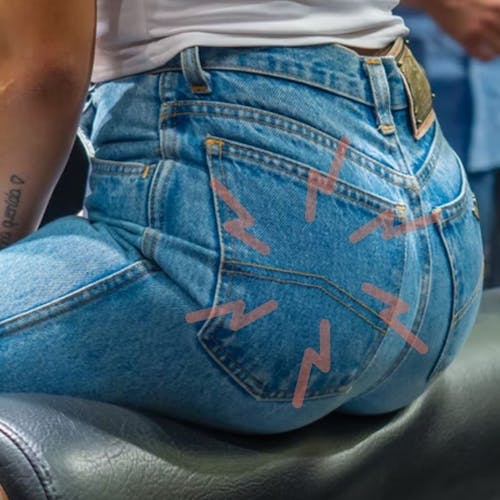This website uses cookies to enhance the user experience. By using Yoppie you are agreeing to our use of cookies.
PMS Back Pain & What To Do About It
Written by Yoppie
27 Dec 2021
Why do I get back pain during PMS?
Is PMS back pain anything to worry about?
What can I do about PMS back pain?
How can I manage day-to-day PMS back pain myself?
Do your PMS symptoms include an achy or twinge-y lower back each month? Though this symptom is pretty common around your period, if the pain becomes more severe there may be something else going on. Here’s the lowdown on why this happens, how to manage it in a safe way, and what to do if it gets bad enough to affect your movement and daily life…
Why do I get back pain during PMS?
Period pain comes in many different forms, and lots of us will experience a little lower back ache before and during our period in the same way that we get tummy and sometimes pelvic pain. But for some people this can feel a lot worse, causing severe monthly lower back pain. Why? You guessed it, it’s our good friends… hormones!
More specifically, it’s mostly down to an increase in hormones called prostaglandins. Though the two may seem unrelated, prostaglandins are released to promote the contraction of the uterus during your period to make it shed its lining, and these contractions can cause pain that travels to the lower back. Inflammation could also be a cause; in one study, researchers found those with higher inflammatory markers during menstruation were more likely to have cramps and lower back pain.
Is PMS back pain anything to worry about?
Severe lower back pain could be a symptom of another underlying period-related condition. Here are a few of the most common:
- PMDD stands for premenstrual dysphoric disorder, and it’s often thought of as a much more intense form of PMS that can interfere with daily life and relationships. Symptoms can include more severe depression, anxiety and mood swings, gastrointestinal symptoms like diarrhoea or vomiting, and other symptoms like pelvic pressure, headaches, changes in appetite and changes in sleep patterns.
- Dysmenorrhea is another term for painful menstruation, where the uterus contracts more intensely than for other people. This can cause severe and sometimes debilitating cramps, pain in the legs, and more, including lower back pain. One study found that over 84% of respondents experienced primary dysmenorrhea, and 16% of those respondents reported lower back pain which felt like spasms, shooting pains or “stabbing” pains.
- Endometriosis is a condition where tissue that is supposed to grow inside the uterus ends up growing elsewhere and causing issues. When this happens, it can result in varying levels of pelvic pain, heavy periods, and of course lower back pain.
If you suspect you may have one of the above conditions, don’t delay speaking to your doctor so they can recommend the appropriate treatment and get you doing cartwheels in no time (or at least living without back pain!)
What can I do about PMS back pain?
First things first; book a GP appointment. They should be able to recommend the best treatment options for your particular situation, and there are lots of options available so you should never have to live with any kind of severe pain, even if it only happens once a month.
Some of the most common options include hormonal birth control to manage the overall symptoms, anti-inflammatory medicines to lessen the pain you’re feeling, and in severe cases where the underlying cause is endometriosis, surgery can also help. In one study a TENS machine was used alongside spinal manipulation and heat to reduce dysmenorrhea pain, so you never know what your doctor may suggest to help ease the discomfort.
How can I manage day-to-day PMS back pain myself?
There’s always the option of starting to take an anti-inflammatory like ibuprofen a couple of days before your period starts to get ahead of symptoms, but you shouldn’t rely on this as a long-term strategy. If you’re hoping to avoid the use of painkillers, there are a few home remedies that could help, such as:
- Applying a heating pad or hot water bottle to the lower back or affected area
- Taking a hot shower or bath to ease the pain
- Booking in for a back massage or acupuncture session to ease muscle pain
- Doing some gentle exercise, like a walk, calming yoga or just some stretches
- Adjusting your sleeping position to take pressure off the lower back
- Sticking to a healthy diet with plenty of water, and no caffeine, alcohol or smoking, to relieve period pain
- Taking supplements like our Super Soother, which includes plenty of magnesium to promote regular muscle function
You should always see your doctor if your monthly pain is severe, new, worsening, or stopping you from living your normal life. Also see your doctor if your monthly bleeding is getting heavier, or you have other symptoms such as muscle spasms, pain when walking, pain during sex or spotting. In a nut shell? If in doubt, get checked out.
Got a question about lower back pain and periods? Chat over in our Full Stop FB group or ask us anything on Instagram at @itsyoppie - we’re always keen to hear from you! Don't forget that our personalised menstrual care subscription can get organic tampons, PMS supplements and much more delivered easily and regularly through your letterbox - that's a bit less pain in the neck, back (and wherever else) each month.
Section jump
Back to top
Subscribe To Our Newsletter
YOPPIE





© 2025 Yoppie is a registered trademark of Phlo Technologies Ltd.
Yoppie's supplements are not a substitute for a varied diet and healthy lifestyle and are not intended to diagnose, treat, or cure any disease. If you are pregnant, breastfeeding, have a medical condition or are under medical supervision, please consult with your doctor before taking any of our products.






